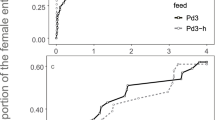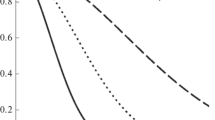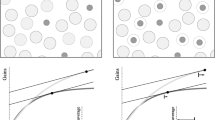Abstract
The Charnov Marginal Value Theorem (MVT) predicts the optimal foraging duration of animals exploiting patches of resources. The predictions of this model have been verified for various animal species. However, the model is based on several assumptions that are likely too simplistic. One of these assumptions is that animals are living forever (i.e., infinite horizon). Using a simple dynamic programming model, we tested the importance of this assumption by analysing the optimal strategy for time-limited foragers. We found that, for time-limited foragers, optimal patch residence times should be greater than those predicted from the classic, static MVT, and the deviation should increase when foragers are approaching the end of their life. These predictions were verified for females of the parasitoid Anaphes victus (Hymenoptera: Mymaridae) exploiting egg patches of its host, the carrot weevil Listronotus oregonensis (Coleoptera: Curculionidae). As predicted by the model, females indeed remained for a longer time on host patches when they approached the end of their life. Experimental results were finally analysed with a Cox regression model to identify the patch-leaving decision rules females used to behave according to the model’s predictions.





Similar content being viewed by others
References
Bernstein C, Kacelnik A, Krebs JR (1988) Individual decisions and the distribution of predators in a patchy environment. J Anim Ecol 57:1007–1026
Bernstein C, Kacelnik A, Krebs JR (1991) Individual decisions and the distribution of predators in a patchy environment. II. The influence of travel costs and structure of the environment. J Anim Ecol 60:205–225
Boivin G (1988) Laboratory rearing of Anaphes sordidatus (Girault) (Hymenoptera: Mymaridae) on carrot weevil eggs (Coleoptera: Curculionidae). Entomophaga 33:131–134
Boivin G (1999) Integrated management for carrot weevil. Integr Pest Manag Rev 4:21–37
Boivin G, van Baaren J (2000) The role of larval aggression and mobility in the transition between solitary and gregarious development in parasitoid wasps. Ecol Lett 3:469–474
Boivin G, Fauvergue X, Wajnberg E (2004) Optimal patch residence time in egg parasitoids: innate versus learned estimate of patch quality. Oecologia 138:640–647
Bonser B, Wright PJ, Bament S, Chukwu UO (1998) Optimal patch use by foraging workers of Lasius fuliginosus, L. niger and Myrmica ruginodis. Ecol Entomol 23:15–21
Brown JS (1988) Patch use as an indicator of habitat preference, predation risk, and competition. Behav Ecol Sociobiol 22:37–47
Bulmer M (1994) Theoretical evolutionary ecology. Sinauer Associates, Inc., Sunderland
Charnov EL (1976) Optimal foraging: the marginal value theorem. Theor Popul Biol 9:129–136
Clark CW, Mangel M (2000) Dynamic state variable models in ecology. Methods and applications. Oxford University Press, New York
Collett D (1994) Modelling survival data in medical research. Chapman & Hall, London
Cook RM, Hubbard SF (1977) Adaptive searching strategies in insect parasites. J Anim Ecol 46:115–125
Cox DR (1972) Regression models and life tables. J R Stat Soc B 74:187–220
Cox DR (1975) Partial likelihood. Biometrika 62:269–276
Driessen G, Bernstein C (1999) Patch departure mechanisms and optimal host exploitation in an insect parasitoid. J Anim Ecol 68:445–459
Driessen G, Bernstein C, van Alphen JJM, Kacelnik A (1995) A count-down mechanism for host search in the parasitoid Venturia canescens. J Anim Ecol 64:117–125
Fletcher JP, Hughes JP, Harvey IF (1994) Life expectancy and egg load affect oviposition decisions of a solitary parasitoid. Proc R Soc Lond 258:163–167
Giraldeau LA (1997) The ecology of information use. In: Krebs JR, Davies NB (eds) Behavioural ecology, 4th edn. Blackwell, Oxford, pp 42–68
Gladstein DS, Carlin NF, Austad SN (1991) The need for sensitivity analyses of dynamic optimization models. Oikos 60:121–126
Godfray HCJ (1994) Parasitoids. Behavioral and evolutionary ecology. Princeton University Press, Princeton
Green RF (1980) Bayesian birds: a simple example of Oaten’s stochastic model of optimal foraging. Theor Popul Biol 18:244–256
Green RF (1984) Stopping rules for optimal foragers. Am Nat 123:30–40
Haccou P, de Vlas SJ, van Alphen JJM, Visser ME (1991) Information processing by foragers: effects of intra-patch experience on the leaving tendency of Leptopilina heterotoma. J Anim Ecol 60:93–106
Haccou P, Sjerps M, van der Meijden E (1999) To leave or to stay, that is the question: prediction from models of patch-leaving strategies. In: Olff H, Brown VK, Drent RH (eds) Herbivores: between plants and predators. Blackwell, Oxford, pp 85–108
Hassell MP (1978) The dynamics of arthropod predator–prey systems. Princeton University Press, Princeton
Henneman ML (1998) Maximization of host encounters by parasitoids foraging in the field: females can use a simple rule. Oecologia 116:467–474
Holling CS (1959) Some characteristics of simple types of predation and parasitism. Can Entomol 91:385–398
Houston AI (1987) The control of foraging decisions. In: Commons ML, Kacelnik A, Shettleworth SJ (eds) Quantitative analysis of behavior, vol IV. Erlbaum, Mahwah, pp 41–61
Houston AI, Clark CW, McNamara JM, Mangel M (1988) Dynamic models in behavioral and evolutionary ecology. Nature 332:29–34
Houston AI, Welton NJ, McNamara JM (1997) Acquisition and maintenance costs in the long-term regulation of avian fat reserves. Oikos 78:331–340
Hubbard SF, Cook RM (1978) Optimal foraging by parasitoid wasps. J Anim Ecol 47:593–604
Hutchinson JMC, McNamara JM (2000) Ways to test stochastic dynamic programming models empirically. Anim Behav 59:665–676
Iwasa Y, Higashi M, Yamamura N (1981) Prey distribution as a factor determining the choice of optimal foraging strategy. Am Nat 117:710–723
Keasar T, Ney-Nifle M, Mangel M, Swezey S (2001) Early oviposition experience affects patch residence time in a foraging parasitoid. Entomol Exp Appl 98:123–132
Krebs JR, Kacelnik A, Taylor P (1978) Test of optimal sampling by foraging great tits. Nature 275:27–31
Li C, Roitberg BD, Mackauer M (1993) Patch residence time and parasitism of Aphelinus asychis: a simulation model. Ecol Model 69:227–241
Mangel M (1993) Motivation, learning, and motivated learning. In: Papaj DR, Lewis AC (eds) Insect learning. Ecological and evolutionary perspectives. Chapman & Hall, London, pp 158–173
Maynard Smith J (1982) Evolution and the theory of games. Cambridge University Press, Cambridge
McNair JM (1982) Optimal giving-up time and the marginal value theorem. Am Nat 119:511–529
McNamara JM (1982) Optimal patch use in a stochastic environment. Theor Popul Biol 21:269–288
McNamara JM, Houston AI (1985) Optimal foraging and learning. J Theor Biol 117:231–249
McNamara JM, Houston AI (1986) The common currency for behavioural decisions. Am Nat 127:358–378
McNamara JM, Houston AI (1987a) Memory and the efficient use of information. J Theor Biol 125:285–395
McNamara JM, Houston AI (1987b) Foraging in patches: there’s more to life than the Marginal Value Theorem. In: Commons ML, Kacelnik A, Shettleworth SJ (eds) Quantitative analysis of behavior, vol IV. Erlbaum, Mahwah, pp 23–39
Newman JA (1991) Patch use under predation hazard: foraging behavior in a simple stochastic environment. Oikos 61:29–44
Nonacs P (2001) State dependent behavior and the Marginal Value Theorem. Behav Ecol 12:71–83
Oaten A (1977) Optimal foraging in patches: a case for stochasticity. Theor Popul Biol 12:263–285
Ollason JG (1980) Learning to forage—optimally? Theor Popul Biol 18:44–56
Olsson O, Holmgren NMA (1998) The survival-rate-maximizing policy for Bayesian foragers: wait for good news. Behav Ecol 9:345–353
Picard C, Auclair JL, Boivin G (1991) Response to host age of the egg parasitoid Anaphes n.sp. (Hymenoptera: Mymaridae). Biocontrol Sci Technol 1:169–176
Roitberg BD, Mangel M, Lalonde RG, Roitberg CA, van Alphen JJM, Vet L (1992) Seasonal dynamic shifts in patch exploitation by parasitic wasps. Behav Ecol 3:156–165
Roitberg BD, Sircom J, Roitberg CA, van Alphen JJM, Mangel M (1993) Life expectancy and reproduction. Nature 364:108
Rosenheim JA, Mangel M (1994) Patch-leaving rules for parasitoids with imperfect host discrimination. Ecol Entomol 19:374–380
Rosenheim JA, Rosen D (1991) Foraging and oviposition decisions in the parasitoid Aphytis lignanensis: distinguishing the influences of egg load and experience. J Anim Ecol 60:373–389
Sjerps M, Haccou P (1994) Effect of competition on optimal patch leaving: a war of attrition. Theor Popul Biol 46:300–318
Stephens DW, Krebs JR (1986) Foraging theory. Princeton University Press, Princeton
Tenhumberg B, Keller MA, Possingham HP (2001) Using Cox’s proportional hazards models to implement optimal strategies: an example from behavioural ecology. Math Comput Model 33:597–607
Thiel A, Hoffmeister TS (2004) Knowing your habitat: linking patch-encounter rate and patch exploitation in parasitoids. Behav Ecol 15:419–425
van Alphen JJM (1988) Patch-time allocation by insect parasitoids: superparasitism and aggregation. In: de Jong G (ed) Population genetics and evolution. Springer, Berlin Heidelberg New York, pp 216–221
van Alphen JJM, Bernstein C, Driessen G (2003) Information acquisition and time allocation in insect parasitoids. Trends Ecol Evol 18:81–87
van Baaren J, Boivin G (1998a) Genotypic and kin discrimination in a solitary hymenopterous parasitoid: implications for speciation. Evol Ecol 12:523–534
van Baaren J, Boivin G (1998b) Learning affects host discrimination behavior in a parasitoid wasp. Behav Ecol Sociobiol 42:9–16
van Baaren J, Boivin G, Nénon JP (1994) Intra- and interspecific host discrimination in two closely related egg parasitoids. Oecologia 100:325–330
Venables WN, Ripley BD (1994) Modern applied statistics with S-Plus. Springer, Berlin Heidelberg New York
Visser ME, van Alphen JJM, Nell HW (1992) Adaptive superparasitism and patch time allocation in solitary parasitoids: the influence of pre-patch experience. Behav Ecol Sociobiol 31:163–171
Waage JK (1979) Foraging for patchily-distributed hosts by the parasitoid, Nemeritis canescens. J Anim Ecol 48:353–371
Wajnberg E, Rosi MC, Colazza S (1999) Genetic variation in patch-time allocation in a parasitic wasp. J Anim Ecol 68:121–133
Wajnberg E, Fauvergue X, Pons O (2000) Patch leaving decision rules and the Marginal Value Theorem: an experimental analysis and a simulation model. Behav Ecol 11:577–586
Wajnberg E, Gonsard PA, Tabone E, Curty C, Lezcano N, Colazza S (2003) A comparative analysis of patch-leaving decision rules in a parasitoid family. J Anim Ecol 72:618–626
Wajnberg E, Curty C, Colazza S (2004) Genetic variation in the mechanisms of direct mutual interference in a parasitic wasp: consequences in terms of patch-time allocation. J Anim Ecol 73:1179–1189
Ward JF, Austin RM, MacDonald DW (2000) A simulation model of foraging behaviour and the effect of predation risk. J Anim Ecol 69:16–30
Yamada Y (1988) Optimal use of patches by parasitoids with a limited fecundity. Res Popul Ecol 30:235–249
Yamamura N, Tsuji N (1987) Optimal patch time under exploitative competition. Am Nat 129:553–567
Acknowledgements
This work was supported in part by research grants from the Natural Sciences and Engineering Research Council (NSERC) to G. Boivin. J. Vaillancourt is thanked for her technical assistance. T.S. Hoffmeister, R.H. Messing, E. Mondor, P. Nonacs, J.S. Pierre and B.D. Roitberg are thanked for their comments on an earlier version of the manuscript. This work is part of GDR 2155 ‘Ecologie Comportementale’ [Centre National de la Recherche Scientifique (CNRS) commission 29] and the European Science Foundation (ESF)/Behavioural Ecology of Insect Parasitoids (BEPAR) scientific programme. All the experimental procedures conformed to French and Canadian law.
Author information
Authors and Affiliations
Corresponding author
Additional information
Communicated by H. Kokko
Rights and permissions
About this article
Cite this article
Wajnberg, E., Bernhard, P., Hamelin, F. et al. Optimal patch time allocation for time-limited foragers. Behav Ecol Sociobiol 60, 1–10 (2006). https://doi.org/10.1007/s00265-005-0131-7
Received:
Revised:
Accepted:
Published:
Issue Date:
DOI: https://doi.org/10.1007/s00265-005-0131-7




